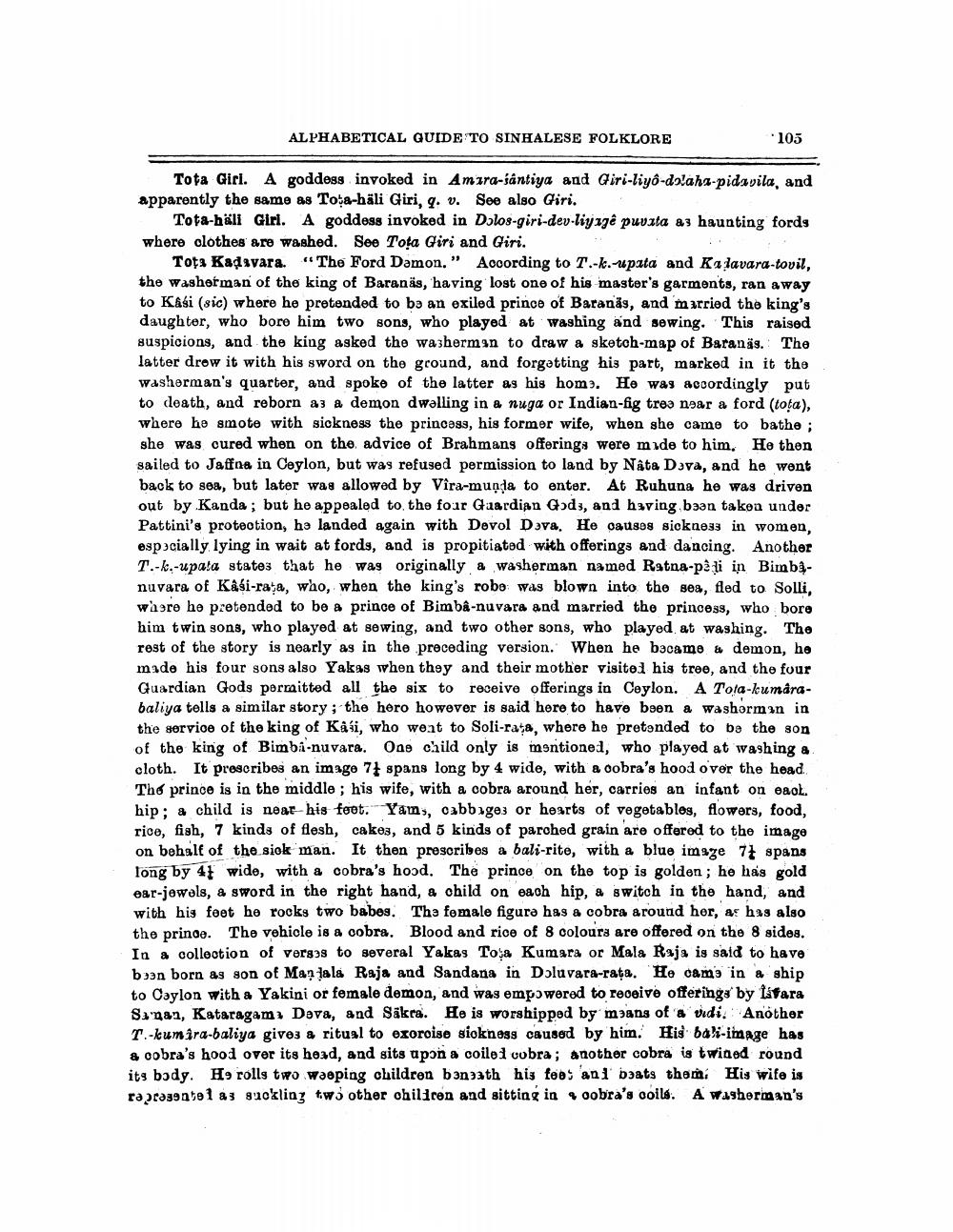________________
ALPHABETICAL GUIDE TO SINHALESE FOLKLORE
105
Tota Giri. A goddess invoked in Amira-śântiya and Giri-liyo-dolaha-pidavila, and apparently the same 88 Tota-häli Giri, q. v. See also Giri.
Tota-häll Girl. A goddess invoked in Dolos-giri-dev-liyagê puvata a3 haunting fords where clothes are washed. See Toga Giri and Giri.
Tota Kadavara. "The Ford Damon.” According to T.-L.-upata and Kalavara-tovil, the washerman of the king of Baranäs, having lost one of his master's garments, ran away to Kasi (sic) where he pretended to be an exiled prince of Baranås, and married the king's daughter, who bore him two sons, who played at washing and sewing. This raised suspicions, and the king asked the washerman to draw a sketch-map of Baranäg. The latter drow it with his sword on the ground, and forgetting his part, marked in it the washerman's quarter, and spoke of the latter as his hom. He was accordingly put to death, and reborn as a demon dwalling in a nuga or Indian-fig tree near a ford (tota), where he smote with sickness the princess, his former wife, when she came to bathe ; she was cured when on the advice of Brahmans offerings were made to him. He then sailed to Jaffna in Ceylon, but was refused permission to land by Nata Dva, and he went back to sea, but later was allowed by Vira-munda to enter. At Ruhuna he was driven out by Kanda ; but he appealed to the four Guardian Gods, and having been taken under Pattini's protection, he landed again with Devol Duva. He causes sickness in women, especially lying in wait at fords, and is propitiated with offerings and dancing. Another T.-k.-upata states that he was originally a washerman named Ratna-pali in Bimbinuvara of Kasi-rata, who, when the king's robe was blown into the sea, fled to Solli, where he pretended to be a prince of Bimba-nuvara and married the princess, who bore him twin sons, who played at sewing, and two other sons, who played at washing. The rest of the story is nearly as in the preceding version. When he became a demon, he made his four sons also Yakas when they and their mother visited his tree, and the four Guardian Gods permitted all the six to receive offerings in Ceylon. A Tota-kumarabaliya tells a similar story; the hero however is said here to have been a washormon in the service of the king of Kasi, who went to Soli-rata, where he pretended to be the son of the king of Bimbi-nuvara. One child only is mentioned, who played at washing a cloth. It prescribes an image 7 spans long by 4 wide, with a cobra's hood over the head. The prince is in the middle; his wife, with a cobra around her, carries an infant on eact. hip: a child is near his foot. Yams, cabbage or hearts of vegetables, flowers, food, rice, fish, 7 kinds of flesh, cakes, and 5 kinds of parched grain are offered to the image on behalf of the siok man. It then prescribes a bali-rite, with a blue image 77 spans long by 4 wide, with a cobra's hood. The prince on the top is golden; he has gold ear-jewels, a sword in the right hand, & child on each hip, a switch in the hand, and with his feet he rocks two babes. The female figura has a cobra around her, as has also the prince. The vehicle is a cobra. Blood and rice of 8 colours are offered on the 8 sides. In a collection of verg) to several Yakas Toja Kumara or Mala Raja is said to have buon born as son of Man lala Raja and Sandana in Döluvara-rata. He cams in a ship to Caylon with a Yakini or female demon, and was empowered to receive offering by tátara Sunan, Kataragam Deva, and Säkra. He is worshipped by mans of a vidi. Another T-kumira-baliya give3 & ritual to exorcise siokness caused by him. His bali-image has & cobra's hood over its head, and sits upon a coile i cobra; another cobra is twined round its body. H9 rolls two waeping children b3n3th his fee: 'an i bəats them. His wife is ra ca39ate 1 a 3 suokling tw other children and sitting in cobra's ooils. A wisherman's




